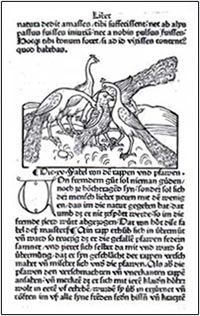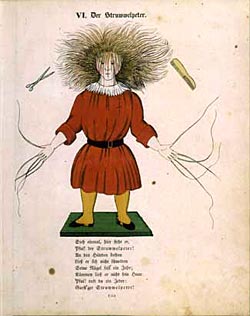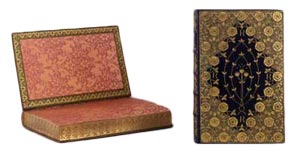
Aesop, Vitae et fabulae. Ulm, [ca. 1476]. PML 23211
The Department of Printed Books contains works spanning Western book production from the earliest printed ephemera to important first editions from the twentieth century. While relatively modest in size, the collection encompasses a large number of high points in the history of printing, often exemplified by a lone surviving copy or a copy that is perfect in every way. Areas of exceptional strength include incunables, early children's books, fine bindings, and illustrated books.
Collecting History
The collection's strong base derives from the major acquisitions of Pierpont Morgan, who set out to establish in the United States a library equal to the great European collections. His purchase of entire collections between the late 1890s and the eve of the First World War produced a library notable for its breadth and depth. Among the great libraries acquired by Morgan were those assembled by James Toovey, Theodore Irwin, and Richard Bennett.
Other major collections within the department include the William Morris collection (much of which was the gift of John M. Crawford); the Dannie and Hettie Heineman collection of intellectual and scientific works; the Paul Mellon gift of European illustrated books; and the Gordon N. Ray collection of English and French literature and illustrated books. The Carter Burden collection of American literature and the Alton E. Peters collection of T. S. Eliot strengthen the Morgan's twentieth-century holdings.
The collection is strong in historical, literary, and cultural documents of Western civilization, making it possible to study the publishing history of individual works. For example, Aesop editions range from the fifteenth to twentieth centuries, providing evidence of the changes in book production and illustrative processes.
Incunables (Fifteenth Century)
The Morgan's collection of incunables currently numbers 2,697 and includes books, broadsides, blockbooks, and woodcuts. It is rich in special or unique copies, first editions of classical authors, the work of notable printers, such as Nicolas Jenson and William Caxton, and publications issued in remote towns, showing how printing spread throughout Europe during the fifteenth century. The Morgan has the distinction of owning three Gutenberg Bibles, one on vellum, and two on paper.
See a selection of incunable bookbindings »
Sixteenth Century
The largest single group within the library of James Toovey consisted of Greek and Latin classics printed at the Aldine Press in Venice. Subsequent acquisitions have increased the Morgan's holdings of Aldines to more than five hundred volumes. A working library of almost three hundred volumes, all in original bindings, formed in the sixteenth century by the Ramey family of Forez, is another part of the collection, along with numerous Bibles, psalters, early editions of the Book of Common Prayer, and early printed editions of works by major figures of the Reformation and Counter-Reformation.
Seventeenth and Eighteenth Centuries
About 1,200 titles from the seventeenth century include Bibles, psalters, prayer books, and a large collection of works by Molière. The eighteenth century's 2,300 titles include strong collections of William Blake, Robert Burns, Thomas Chatterton, Henry Fielding, William Godwin, Oliver Goldsmith, Thomas Paine, and Alexander Pope. Among the more significant American historical documents in the collection are the first printing of the Declaration of Independence, several drafts of the Constitution, and journals and reports issued by the Continental Congress.
Nineteenth Century
The 15,000 nineteenth-century titles include a strong collection of works by the English Romantics, particularly George Gordon Byron, and by Victorian authors, including Charles Dickens, William Makepeace Thackeray, John Ruskin, and Anthony Trollope. American literature is represented by Edgar Allan Poe, Mark Twain, Herman Melville, and others. The William Morris collection of more than 250 titles comprises printed copies of works written or translated by Morris or published by the Kelmscott Press as well as extensive documentation of the activities of the press.
Twentieth Century
Strongly represented twentieth-century authors include John Galsworthy, D. H. Lawrence, Rudyard Kipling, and George Bernard Shaw. The Carter Burden collection of American literature contains first editions of every major modern American author since Henry James, including Langston Hughes, Sylvia Plath, Jack Kerouac, Edith Wharton, Vladimir Nabokov, Gertrude Stein, and Tennessee Williams. The Kenneth A. Lohf collection of British poetry is comprehensive in holdings related to poets of the First and Second World Wars. More recent additions to the department include the Man Booker Prize collection of more than 4,000 items relating to authors and judges associated with the literary prize.

Children's Books
Aside from Thackeray's illustrated manuscript for The Rose and the Ring, acquired by J. P. Morgan, Jr., the Morgan's collection of children's books really began with Elisabeth Ball's gift of several thousand English and French works. Funds from her endowment made possible the purchase of the Wilbur Macy Stone-Gillet Griffin collection of American children's books as well as many important individual acquisitions. Julia P. Wightman's collection of 1,500 children's books includes titles by Kate Greenaway and Beatrix Potter. Arthur Houghton's Lewis Carroll collection contains personal possessions and books from the author's library as well as items that belonged to Alice Liddell.
Fine Bindings
There are many beautiful and important bindings in the Morgan, but the bindings collection comprises about a thousand volumes acquired primarily to document the development of bookbinding.It is among the finest collection of bindings in this hemisphere, equally strong in quantity and quality. Areas of particular distinction are English, French, and Italian bindings of the sixteenth through the early nineteenth century.

Two bindings by T. J. Cobden-Sanderson. Matthew Arnold, Selected Poems. London, 1878 (bound 1890). PML 2110.
Illustrated Books
The Morgan's important holdings of illustrated books range from fifteenth-century woodcuts and illuminated books to modern and contemporary livres d'artistes. The Morgan has a fine collection of blockbooks, including the Netherlandish Canticum canticorum of about 1465. Gordon N. Ray's collection of French and English illustrated books contains lithographic albums, eighteenth- and nineteenth-century French illustrated volumes, and Doré folios. Livres d'artistes include Henry Moore's first work as a book illustrator, Verlaine's Parallèlement illustrated by Bonnard, the Suarès-Rouault copy of Cirque in a binding by Paul Bonet, and the Frances and Michael Baylson collection comprising every book illustrated by Matisse.
CORSAIR, the Morgan's online collection catalog, is available here.
